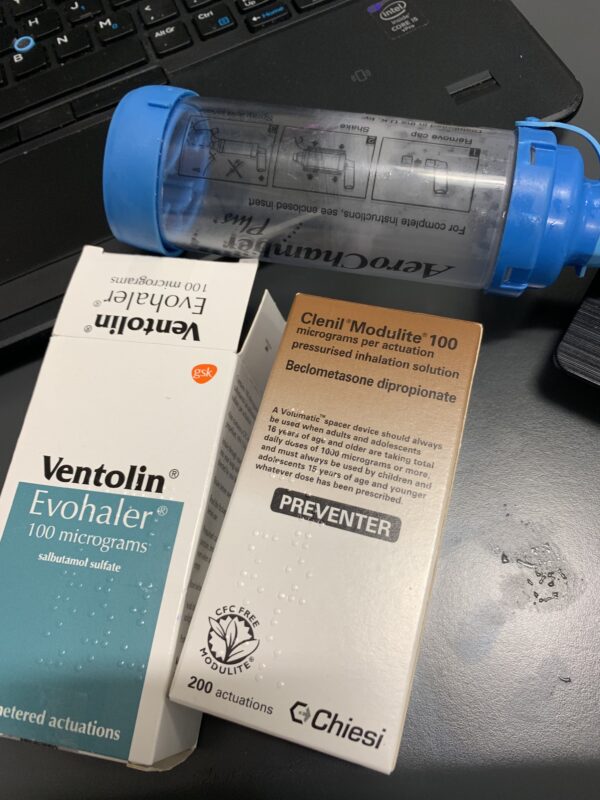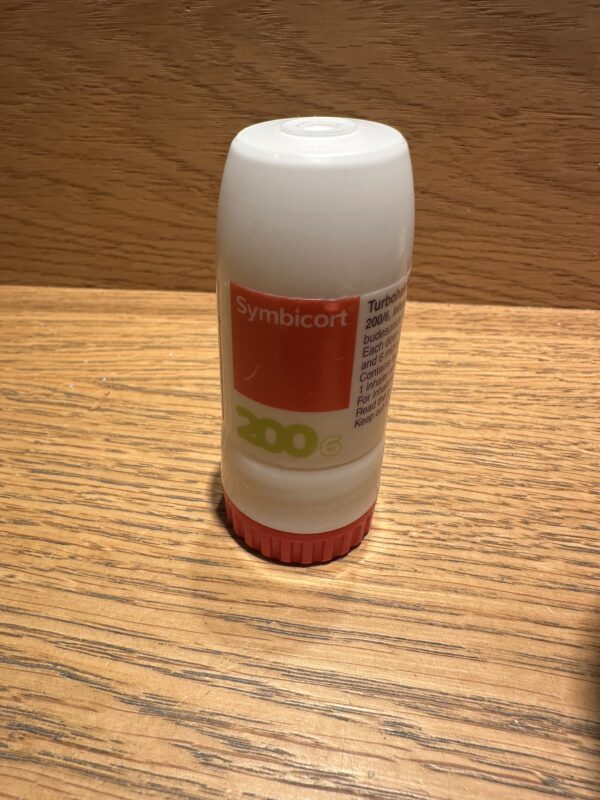The human body is an odd thing. Some of you might remember I have an Asthma problem. Except it hasn’t been a problem for about four years or so – to the point I went off the medications I was using (as I wasn’t using them).

Let’s talk about asthma puffers and travel. Not about my poor taste in coffee.
Well, that changed just over two months or so ago, when it kicked back in with gusto.
As such, it was time to set up appointments with my GP and Nurse to help alleviate issues and get used to new inhalers.
My time away from inhaler land has meant things have changed.
For me, I’m used to what I used to call “Blue and Brown” inhalers – the blue inhaler contains salbutamol, whilst the brown inhaler contains beclometasone dipropionate to act as steroids (Yes, I’m well aware that other countries have different colours. I’m afraid you’ll have to stick with me for the colours on this one).

Asthma and I in 2015. With Ventolin (salbutamol) – Shot 2015. I miss that bacon wallet.

Ventolin Blue Inhaler (salbutamol), Modulite Brown Inhailer (beclometasone dipropionate) with a spacer to make life more difficult (shot 2019)
Now, I have a Symbicort Turbohaler, with a Blue Inhaler issued as a backup (with medical instructions preferred to use the Turbohaler).
This acts both to carry the steroid and reliever, which I can take up to six times a day. It contains budesonide and formoterol fumarate dihydrate… and a very different experience to use (considering this is a dry powder, compared to the aerosol-based solutions, least of all it is one item, as opposed to different puffers for different purposes.
So, here’s some travel advice I would give you if you need to bring medication with you when you travel. Whilst it should be reasonably valid, you should seek appropriate travel advice from the country you’re visiting, your health provider or a professional.
Check what you’re allowed to bring into the country
The dumbest of the dumbest things is to bring a medication that can land you in trouble when you bring it into a country. A perfect example is I can get the Paracetamol & Codeine in tablet form over the counter from my pharmacy for pain relief (although it’s a pretty much last resort over-the-counter drug).
For countries like the UAE and Qatar, you need permission to bring that in. Other countries, such as the USA, do not allow you to bring codeine into the country in any form.
It’s therefore so important to check what medication you can and cannot bring into a country.
HM Government has a helpful page at https://www.gov.uk/take-medicine-in-or-out-uk for those travelling in or out of the UK to get you started. Other governments might too.
Order Medication in Advance
Before you go, remember to order your prescription medication in advance.
In some cases, that means an app interaction, contacting your General Practice/Medical Professional/Primary Care provider and giving them time to get the persciption/e-prescription to your pharmacy. You may need to book appointments if they deem you need a checkup.
Again, allow plenty of time for this to happen. Ringing your GP the day before you travel to order medication will result in disappointment (especially if you’re relying on e-prescriptions, which can take 2-5 working days depending on your GP, even if you’re doing it in advance).
If you’re in the UK, you might be able to order your medication via a third-party service (eg e-Surgery) which can access your NHS Summary of Care Record. I’ve used services like this to get Ventolin in a hurry, but different drugs will be under different regimes and management criteria.
Take only what you need when you travel.
One of the things that makes customs agents raise their eyebrows is bringing excessive medication with you (as this could be seen as “intent to supply”).
Therefore, only take what you need for a trip, rather than bringing excess items. For a simple six-day trip, I brought 1 x Symbicort 200/6 (120 Doses) and 1 x Ventolin (salbutamol) as a backup. I’ve also taken the same combination when I went to Germany.
The customs agent of the country you enter might look dimly at your items if you bring a 1000-count of Paracetamol/Acetaminophen / Ibuprofen / Naproxen Sodium through the border, claiming it is for personal use, if you are checked.
Typically, a three-month supply of medication is allowed, but check with the country you are entering – they will have different rules.
Keep your medication in your Handbaggage/Personal Item
This is going to sound silly, but if an airline loses your luggage and you’re without your medication, it’s going to be a bad time.
Ideally, put the medication in your liquids bag, but ensure it’s in the bag you can reach easily in-flight – that means in your personal item, as opposed to your carry-on luggage. For my Turbohaler, I kept it in my coat pocket.
After all, waking up two people to move out of the way to get to the overhead bin with your medication in it isn’t going to be fun… especially if there is an in-flight service in progress.
Keep the Boxes your medication comes in.
If customs or immigration agents get sniffy with your medication, make sure you bring the cartons with you. It’s a small thing, but with them, you identify that the medication is assigned to you.
Again, check that your medication is legal for consumption in the country before you travel.
Remember to take the medication.
If you’re travelling, one important thing to remember is to take the medication you brought with you.
I’m sad enough that I keep my Turbohaular in my coat pocket (and rinse it often), remembering to keep it under the maximum six doses a day I’m allowed (your dosage requirements will probably be different – obey the advice given to you by your medical professional).
And cheat when you can…
With my Asthma, it is triggered by cold and temperature changes, and when the temperature drops like a stone. As such, I have to be careful when it gets more than chilly, or if there’s a noticeable drop in temperature.
The coughs I get are good enough to scare many people. As are some of the side effects.
This is one of those times of limiting yourself to temperature changes will help – even if it means switching from walking to taking taxis/rideshares, or taking a train a short distance to keep the warmth in you.
The last thing you need is an asthma attack when you don’t need to have one.
Stay safe when travelling… and always keep some medicines on you when you travel. You never know when you need to take them.
Welcome to Economy Class and Beyond. Your no-nonsense guide to network news, honest reviews, in-depth coverage, unique research, as well as the humour and madness I only know how to deliver.
Our Social Media pool has expanded. You can find us across most networks such as @economybeyond on BlueSky, Threads, Mastodon and Instagram!
Also, remember that we are part of the BoardingArea community, bringing you the latest frequent flyer news from around the world.

I would also suggest that you consider taking disposable procedure face masks with you as well as Primatene tablets and a medic alert necklace and card. The face masks can filter out asthma triggering allergans as well as warm breath in cold conditions. The Primatene tablets are old school for asthma relief and are easy to stash in pockets, luggage, handbags, etc. and offer a way to open the airways when the airways are too constricted for the inhalers to get the medicine deep enough into the lungs. The Medic Alert necklace gives you something to show your condition if the attack is servere enough to silence your voice. The corresponding Medic Allert Card in your wallet behind your drivers license/medical insurance card will do the same if you have passed out. Also consider a battery powered portable nebulizer if you are traveling for an extended period. I’m not a doctor, but give suggestions from experience as I have had adult onset asthma for about 40 years and have travelled the globe extensively.